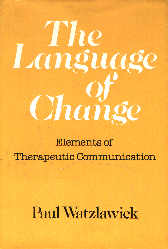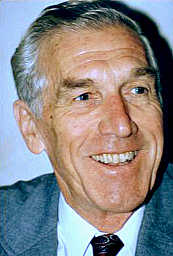This book was written in the mid 1970s when interest swelled in Milton Erickson's
hypnotherapeutic work. Watzlawick dedicated the book as follows:
To Dr. Milton H. Erickson, Who Heals With Words
Around the same time interest in split brain studies began and Right Brain-Left
Brain studies were written up in many journals and books, especially in the field of
psychotherapy. The reductionists even claimed to be able to explain Erickson's techniques in
terms of left-right brain communication. In this book, Watzlawick explains the two languages
of the brain, the left brain mode of the scientist and the right brain mode of the artist. The
studies of the sides of the brain used the standard tool of medicine: examine how a human with
a defect in a certain area acts in order to determine what function missing in one who has a
defect or lesion in that area compared to one without a similar defect in the same area. A
normal person without lesions is like a fish swimming in water who is unable to understand
what water is until it flops out of the water and is unable to breathe. Once a lesion is present
studies of functions are compared to normal persons and pertinent functions are identified for
the area with the lesion.
[page 26] In his book The Double Brain, Diamond mentions several studies
which show that lesions of the right half of the brain can also impair the
execution of sequential processes (for example, dressing), which — I
assume — have become quite automatic as a result of numerous
stereotypical repetitions and were probably stored as right-hemispheric
subroutines, recallable at will before the lesion.
It is normally understood that the left brain controls sequential functions and the right
brain more holistic or global functions. Diamond's studies showed that the global repetition of
certain sequences are stored by the right brain even though they comprise sequences of left
brain functions. Watzlawick goes into details about the split brain experiments with patients
who had their corpus callosum cut, a commissurotomy, as it is called. Severe epileptic seizures
were eliminated by this surgical procedure and only specially constructed experiments could
discern a difference in the patients. They acted as though they had two different brains. Their
visual field and hands acted as a channel of communication to replace the plenum previously
provided by their corpus callosum which connected the two sides of the brain. Thus, the
experiment required that the visual fields be separated and objects placed in the visual field of
one side of the brain be handled by the hand connected to the other side of the brain. Under
those conditions very interesting and insightful results were obtained.
[page 30-31] In the series of neutral geometrical figures being presented at
random to the right and left fields, a nude pin-up was included and flashed
to the right (nonverbal) hemisphere. The girl blushes and giggles. Sperry
asks, "What did you see?" She answers, "Nothing, just a flash of light,"
and giggles again, covering her mouth with her hand. "Why are you
laughing then?" asks Sperry, and she laughs again and says, "Oh, Dr.
Sperry, you have some machine!"
The experimenters noted how similar her response was to someone who might be
repressing some inappropriate sexual material. It is almost as if someone suffering from
repression had achieved a functional commissurotomy such that communication between their
left brain and right brain were blocked for certain subjects even with an otherwise intact corpus
callosum.
[page 31] The minor hemisphere also commonly triggers emotional
reactions of displeasure in the course of ordinary testing. This is evidenced
in the frowning, wincing, and negative head shaking in test situations
where the minor hemisphere, knowing the correct answer but unable to
speak, hears the major hemisphere making obvious verbal mistakes.
The authors are "led to the assumption that we have two conscious minds which,
ideally, are capable of harmonious, complementary integration for the purpose of grasping and
mastering our outer and inner reality, but which, if and when conflict arises, may be unable to
communicate with each other for lack of a common language." (page 38) How does all this
knowledge of left-right brain function become useful in therapy? The author list these three ways and deal with them in separate chapters:
[page 47]
1. The use of right-hemisphere language patterns
2. Blocking the left hemisphere
3. Specific behavior prescriptions
These three chapters 6, 7, and 8 comprise the bulk of the useful part of the book. There
are many examples given in the three chapters, all of them worth reading directly, but I'll share
one in the behavior prescriptions chapter. It involves Milton Erickson, world-renown
hypnotherapist in his time, who paradoxically did his best work without doing anything
identifiable as hypnotic trance. This was one of those cases. A couple who owned a restaurant
came to Milton for help. The wife insisted the husband should manage the restaurant, but the
husband insisted he'd like to manage it, but she won't let him. What did Milton do? He
arranged for the husband to get to the restaurant a half hour before the wife did! That's it. And
here's what happened:
[page 134] When the husband arrived a half hour before his wife, he
carried the key. He opened the door. He unlocked everything. He set up the
restaurant for the day. When his wife arrived, she was completely out of
step and way behind. So many things had been set in motion by him and he
was managing them.
Within a week or two the wife was staying longer at home, finding things to do there,
while her husband showed her that he could run the restaurant. Both parties were happy. All it
took was a little action - no interpretation. Master at work.
Just in case you may think that this example makes it sound all too easy to create deep
pervasive change in a person, let me demonstrate a technique for anticipating resistance offered by
the ancient Greek therapist Aristotle. This is bound to sound a bit ridiculous, but you preempt
the resistance by bringing forth reasons to show that you are justified in offering advice. If you
still don't understand what I'm getting it, let me say that there exists a relatively simple
solution, but I'm almost sure you're not going to understand it or like it at first, especially if
you feel that I'm doing something a little sneaky. This will be difficult for you, because on the
surface this approach is likely to look quite absurd.
The previous paragraph was a summary and a demonstration of the methods the authors give of
"preempting" the resistance (Pages 150-151). If you weren't reading this right now, I would
explain to you a close derivative of preempting which is pretending that you're not saying
something while you actually say it. In fact, when you use the word "not" you are likely using
this very process. "Do not think of a pink elephant." was the example I heard Bandler and
Grinder use a lot in their early seminars in the pre-NLP days. What was the color of the
elephant? Everyone knew it: pink. Try this: as you listen to people talk, drop the not's from
their words. You'll have immediate access to the images or realities that they are living within.
I would not want you to think that you can always re-phrase a sentence containing a not so as to
create a positive image of what you want. I know that as of now most people do not look at
communication that way. Cut that out!
Sorry 'bout that, Chief, got carried away. It will not happen again.
Okay, I'm incorrigible, but if you do not think that this book contains lots of great ideas
about how to achieve deep pervasive change in people's lives, then perhaps you should meet
my friend Tony who told me the other day, "You know, Bobby, there is no such thing as piano
playing; I have myself tried it several times and nothing came of it."
~^~
Any questions about this review, Contact: Bobby Matherne
~~~~~~~~~~~~~~~~~~~~~~~~~~~~~~~~~~~~~~~~~~~~~~~~~~~~~~~~~~

 == == == == == == == == == == == == == == == ==
== == == == == == == == == == == == == == == ==
22+ Million Good Readers have Liked Us
22,454,155
as of November 7, 2019
Mo-to-Date Daily Ave 5,528
Readers
For Monthly DIGESTWORLD Email Reminder:
Subscribe! You'll Like Us, Too!
== == == == == == == == == == == == == == == ==
Click Left Photo for List of All ARJ2 Reviews Click Right Bookcover for Next Review in List
Did you Enjoy this Webpage?
Subscribe to the Good Mountain Press Digest: Click Here!


CLICK ON FLAGS TO OPEN OUR FIRST-AID KIT.
All the tools you need for a simple Speed Trace IN ONE PLACE. Do you feel like you're swimming against a strong current in your life? Are you fearful? Are you seeing red? Very angry? Anxious? Feel down or upset by everyday occurrences? Plagued by chronic discomforts like migraine headaches? Have seasickness on cruises? Have butterflies when you get up to speak? Learn to use this simple 21st Century memory technique. Remove these unwanted physical body states, and even more, without surgery, drugs, or psychotherapy, and best of all: without charge to you.
Simply CLICK AND OPEN the
FIRST-AID KIT.

Counselor? Visit the Counselor's Corner for Suggestions on Incorporating Doyletics in Your Work.

All material on this webpage Copyright 2019 by Bobby Matherne





